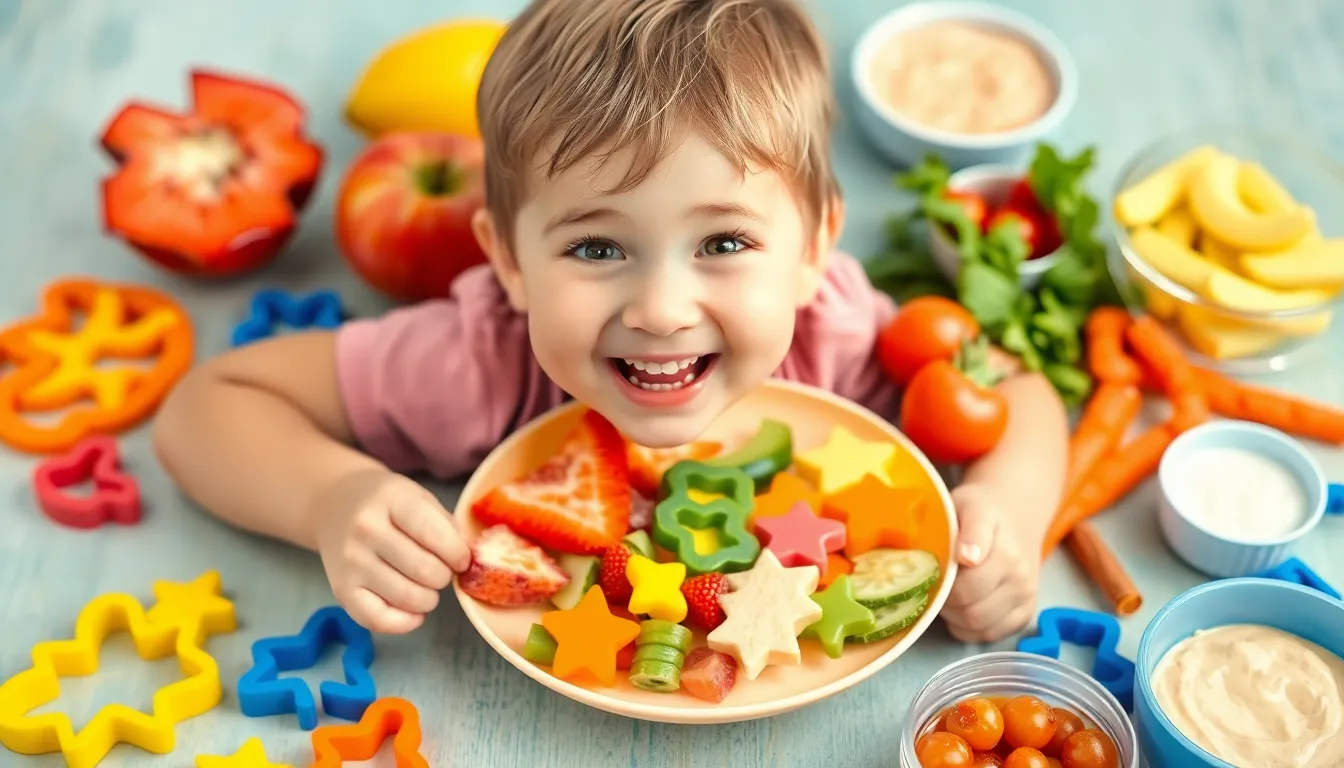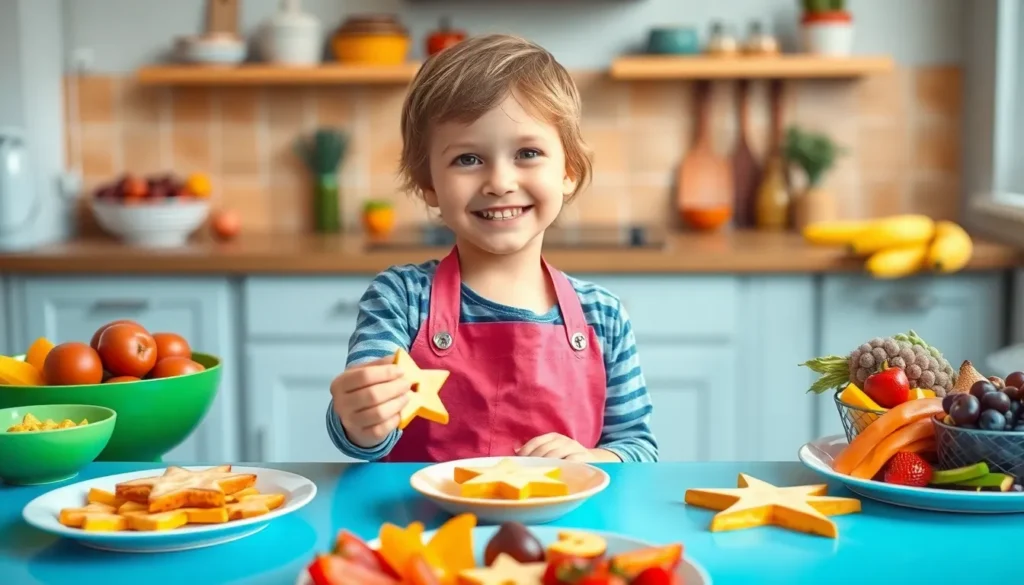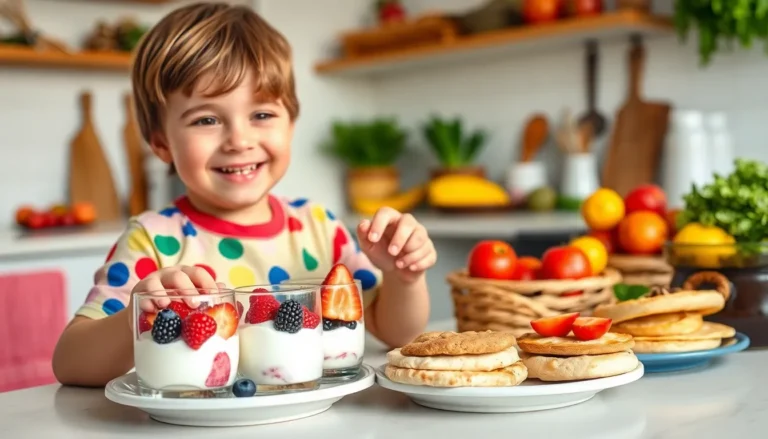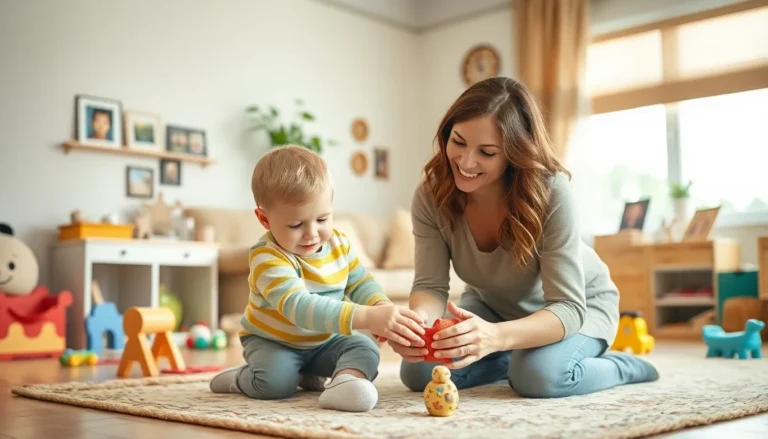Table of Contents
ToggleGetting kids excited about food can feel like herding cats, but it doesn’t have to be a culinary circus. With a sprinkle of creativity and a dash of fun, mealtime can transform into an adventure that even picky eaters will look forward to. Imagine a world where broccoli becomes a tree in a magical forest and carrots are the bright swords of fearless knights.
Food Fun For Kids: An Overview
Making mealtime enjoyable captivates children’s interest while promoting healthy eating habits. Creative presentations transform everyday foods into exciting dishes. For instance, arranging fruits into fun shapes creates a visually appealing plate. Kids enjoy foods shaped like stars or animals, which increases their likelihood of trying new flavors.
Engagement methods enhance the eating experience. Involving children in meal preparation fosters excitement about the foods they help create. Simple tasks like washing veggies or arranging ingredients can deepen their connection to the meal. When children participate, they express ownership and enthusiasm.
Offering themed meals sparks interest. A pirate-themed dinner featuring fish sticks and treasure chest fruit salads captures children’s imagination. Another idea incorporates colors into meals; vibrant rainbow salads can attract even the pickiest eaters. Colorful presentations stimulate curiosity and encourage children to explore various tastes.
Utilizing food-related games adds another layer of fun. Arranging a taste-test challenge allows children to compare different fruits and vegetables while discussing their preferences. Storytelling during meals enhances enjoyment, as kids connect food with imaginative narratives.
Incorporating cooking projects can also provide educational value. Experimenting with age-appropriate recipes teaches children about nutrition, measurements, and techniques. Such activities familiarize them with kitchen skills while increasing their appetite for healthy choices.
Prioritizing creativity, interaction, and imagination in meals leads to positive experiences. Combining these elements creates an engaging atmosphere, making mealtime a fun-filled adventure that promotes a lifetime of healthy eating habits.
Creative Recipes

Creative recipes engage children in fun and interactive ways. These ideas transform ordinary meals into exciting experiences.
Fun Snacks
Make snacks more enjoyable with fun shapes and colors. Use cookie cutters to create fruit and vegetable shapes. Arrange slices of apples, cucumbers, or bell peppers on a plate, adding a dip like yogurt or hummus for extra flavor. Create colorful skewers using grapes, cheese cubes, and cherry tomatoes. Assemble mini sandwiches with whole grain bread and fun fillings, cutting them into animal shapes. Use decorating tools or edible markers on rice cakes, letting kids unleash their creativity. When snacks are playful, children are more likely to embrace healthy options.
Meal Ideas
Theme meals capture kids’ imaginations while nourishing their bodies. Consider a “rainbow plate” featuring an array of colorful vegetables and fruits. Arrange pasta into fun shapes, serving it with homemade sauce and veggies. Set up a taco bar, encouraging children to build their own tacos using various toppings. Create “monster” burgers using black beans and oats, decorating them with olives and pickles. Promote family bonding through a pizza night, allowing kids to choose toppings and design their own pizzas. Engaging them in meal preparation fosters excitement and ownership over their food.
Engaging Activities
Engaging children during mealtime can enhance their food experience and promote healthy habits. Activities like cooking and themed parties create fun learning environments.
Cooking with Kids
Cooking with kids involves fun and educational techniques that foster creativity. Involving children in measuring ingredients encourages basic math skills. Mixing colors while preparing colorful smoothies sparks their imagination. They can help create their own meals, enhancing their interest in different foods. Simple recipes like homemade pizza allow kids to explore flavors while learning about nutrition. Chopping fruits safely with child-friendly utensils also builds confidence in kitchen skills. Following recipes can develop their reading comprehension by engaging them with instructions. Engaging in cooking projects nurtures a lifelong appreciation for healthy eating.
Themed Food Parties
Themed food parties provide an exciting way to enjoy meals together. Planning parties around favorite themes, such as “Under the Sea” or “Outer Space,” can inspire creativity. Decorate dishes to match the theme, like fish-shaped cookies or galaxy cupcakes. Activities like creating unique food stations, such as taco or sundae bars, encourage kids to customize their meals. Inviting friends enhances the social aspect, making food fun and interactive. Games related to the theme can keep children engaged while waiting for food. These celebrations offer a memorable experience that encourages adventurous eating and expands dietary horizons.
Nutrition and Education
Nutrition plays a crucial role in children’s development and education. Engaging kids with creative food presentations fosters enthusiasm for healthy eating. Research indicates that visually appealing meals increase the likelihood of children trying new foods. Additionally, when meals are themed or arranged in fun shapes, children display a greater willingness to explore different flavors. Consistent exposure to nutritious options, such as fruits and vegetables, helps establish a lifelong preference for healthy eating habits.
Healthy Eating Habits
Creating fun and interactive mealtime experiences supports the formation of healthy eating behaviors. Children who participate in meal prep are more inclined to consume nutritious foods. Incorporating a variety of colors and textures into meals captures their attention and encourages adventurous eating. Meal variety, including items like colorful fruit skewers and themed taco bars, introduces children to diverse nutrients. Consistently practicing these habits promotes positive relationships with food, which can lead to healthier choices as they grow older.
Teaching Through Food
Food serves as an excellent medium for teaching valuable life skills. When children help in the kitchen, they learn about measuring ingredients and following recipes, reinforcing math and reading skills. Involving children in meal prep not only nurtures creativity but also strengthens their understanding of nutrition. Cooking simple recipes, like homemade pizza, encourages them to choose healthy toppings and explore different flavors. Utilizing themed meal ideas offers opportunities for discussions about food origins and nutrition, further expanding their knowledge in a fun and engaging way.
Creating a fun and engaging mealtime experience for kids is essential in fostering healthy eating habits. By incorporating creativity and imagination into food presentation and preparation, parents can transform mealtime into an exciting adventure. Engaging children in cooking activities not only enhances their culinary skills but also promotes a positive relationship with food. Themed meals and playful presentations stimulate curiosity and encourage children to explore new flavors. Ultimately, making mealtimes enjoyable lays the foundation for lifelong healthy eating habits, ensuring that children develop a love for nutritious foods while having fun in the kitchen.







